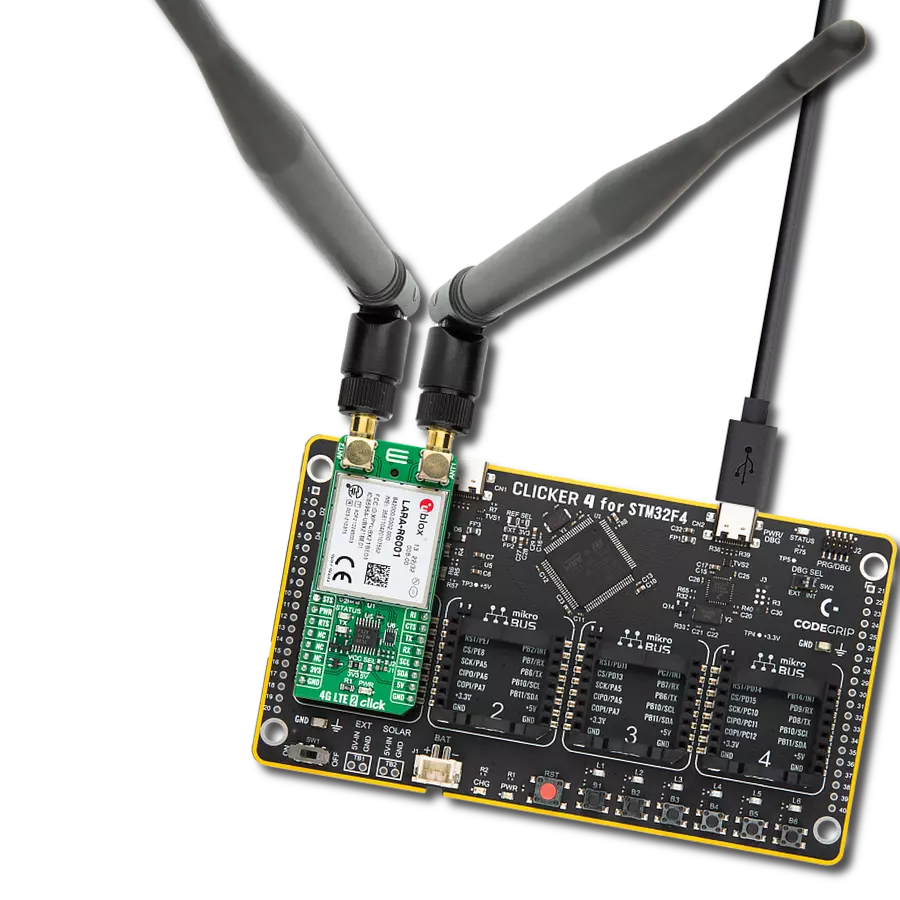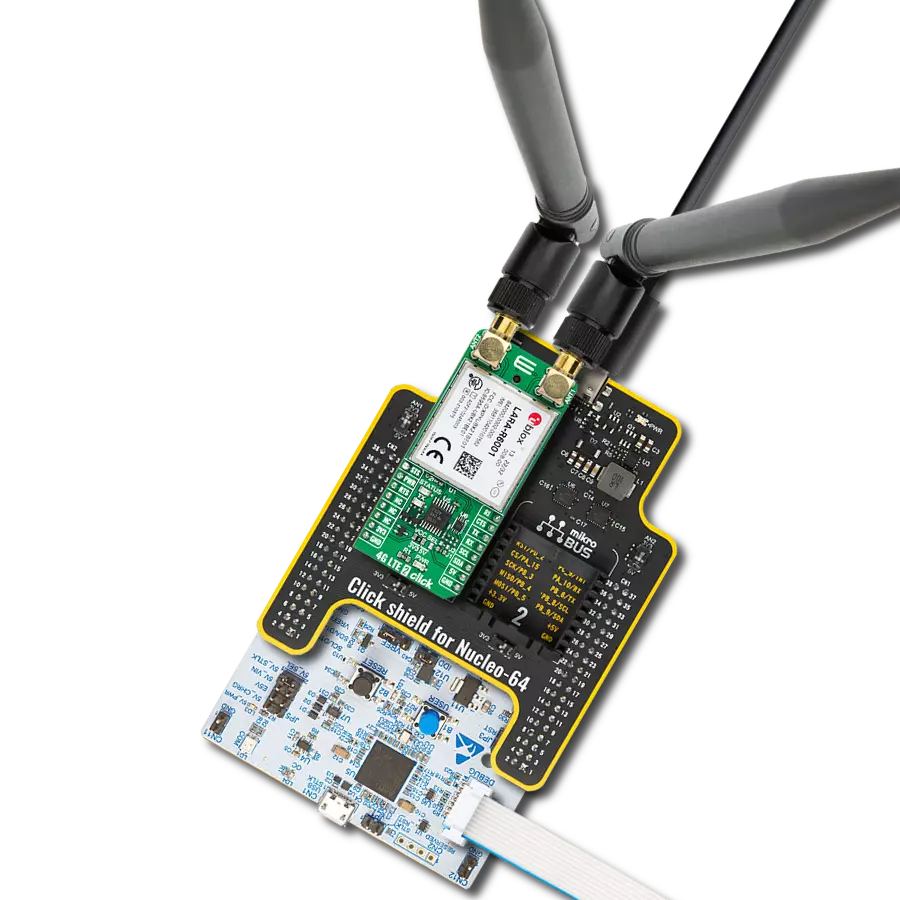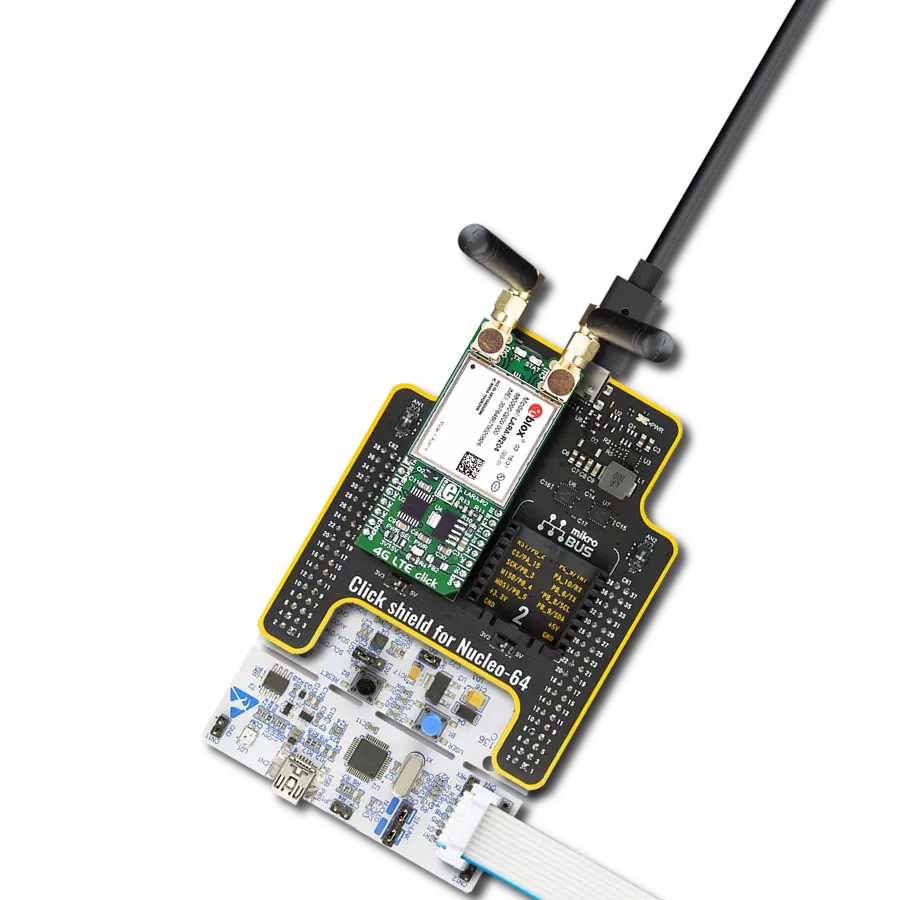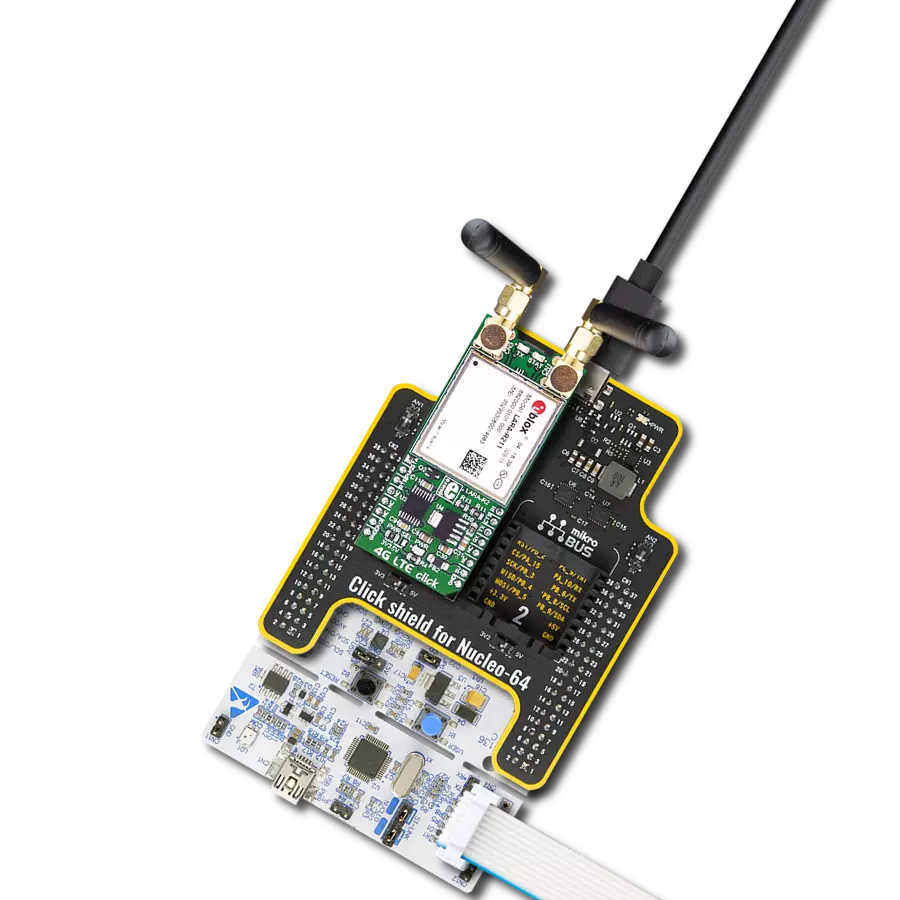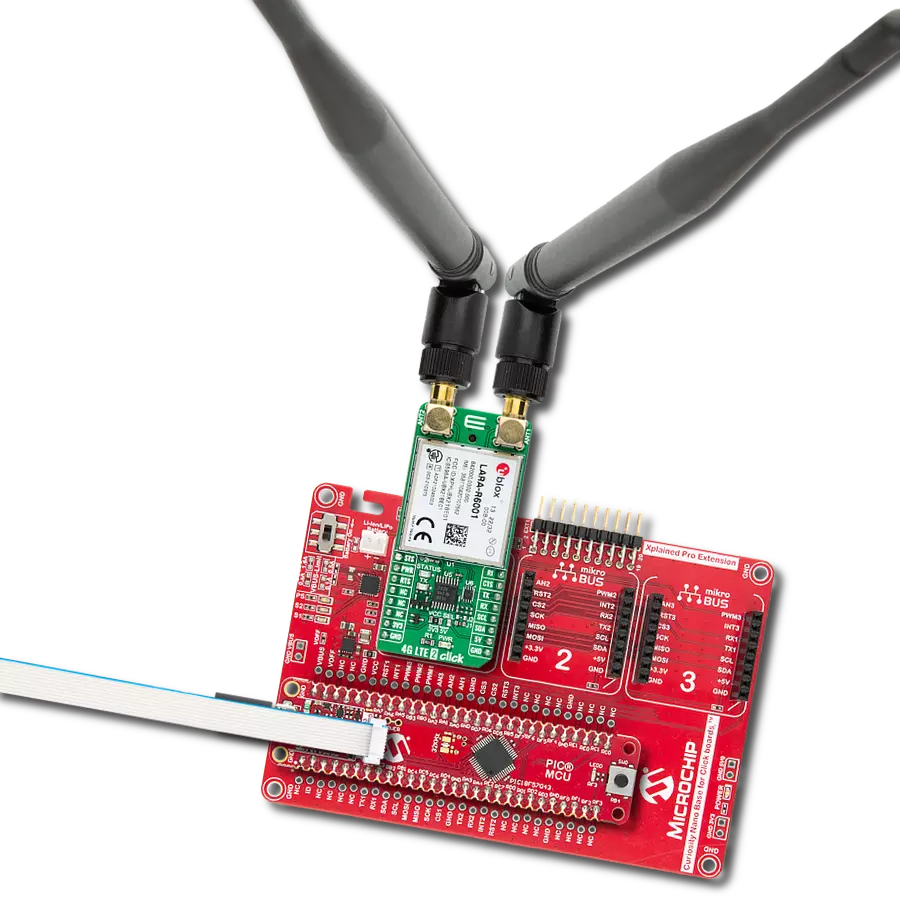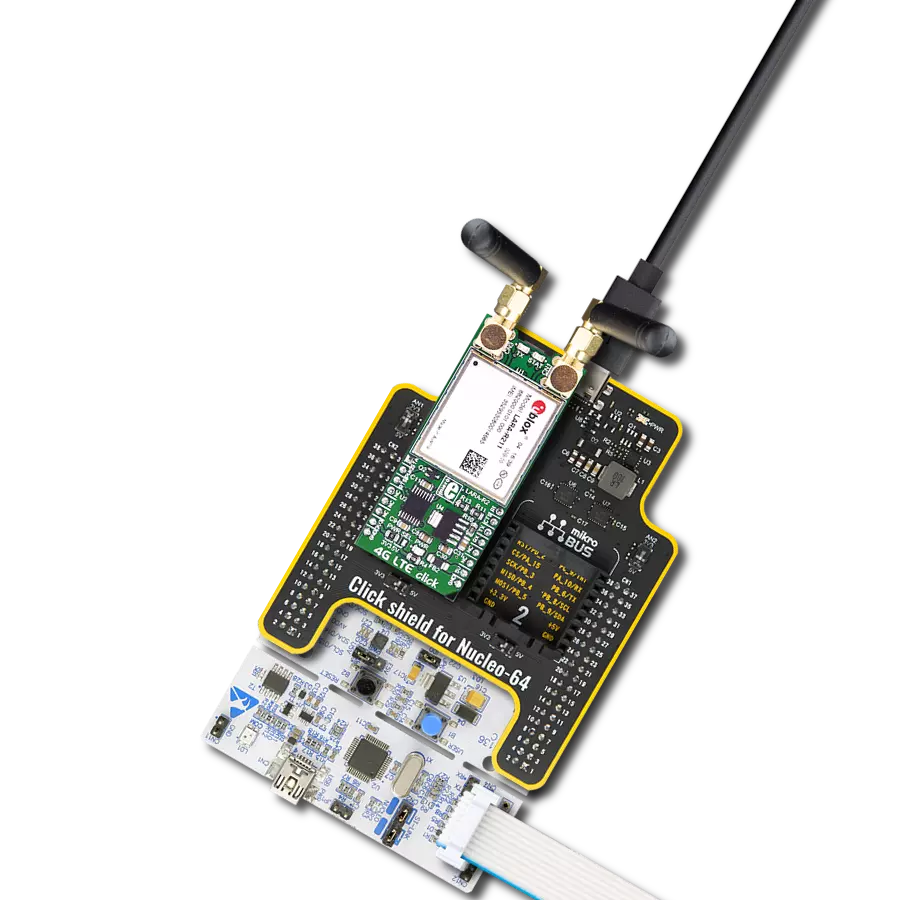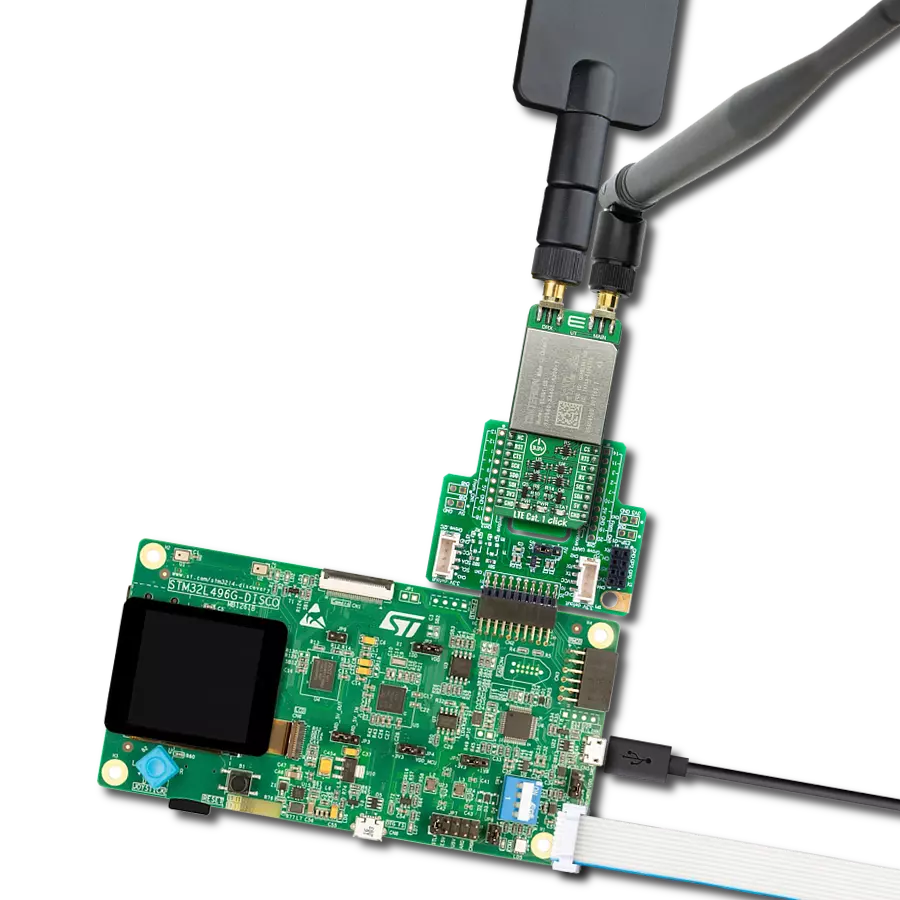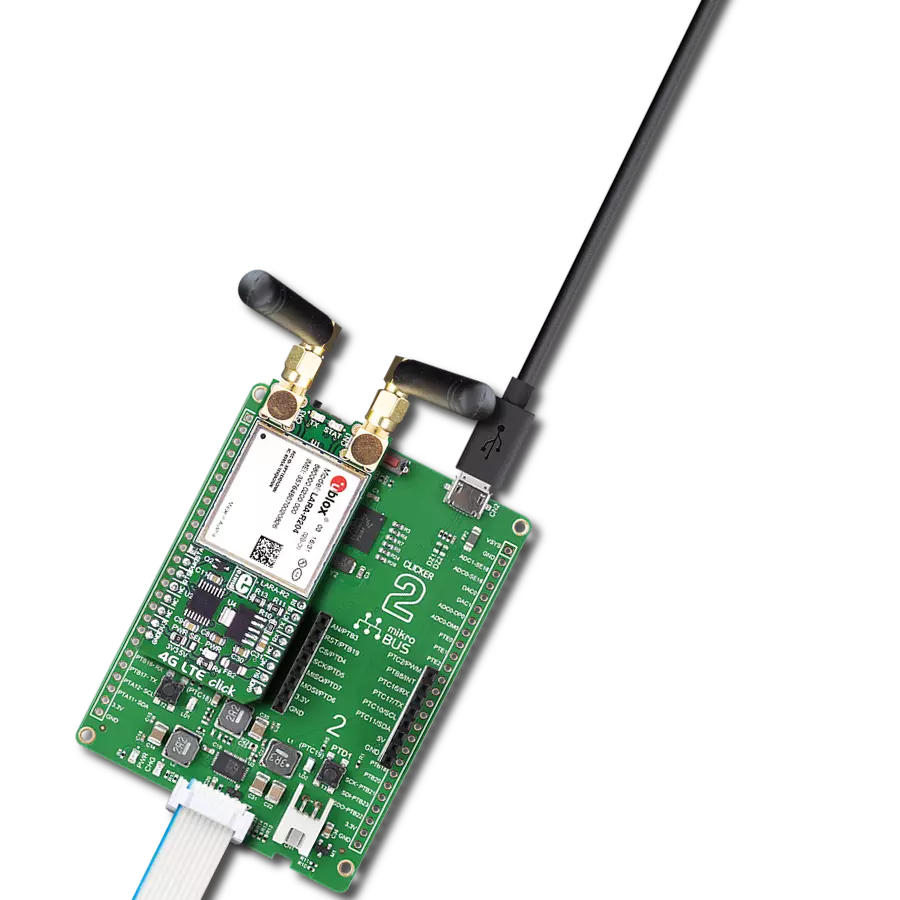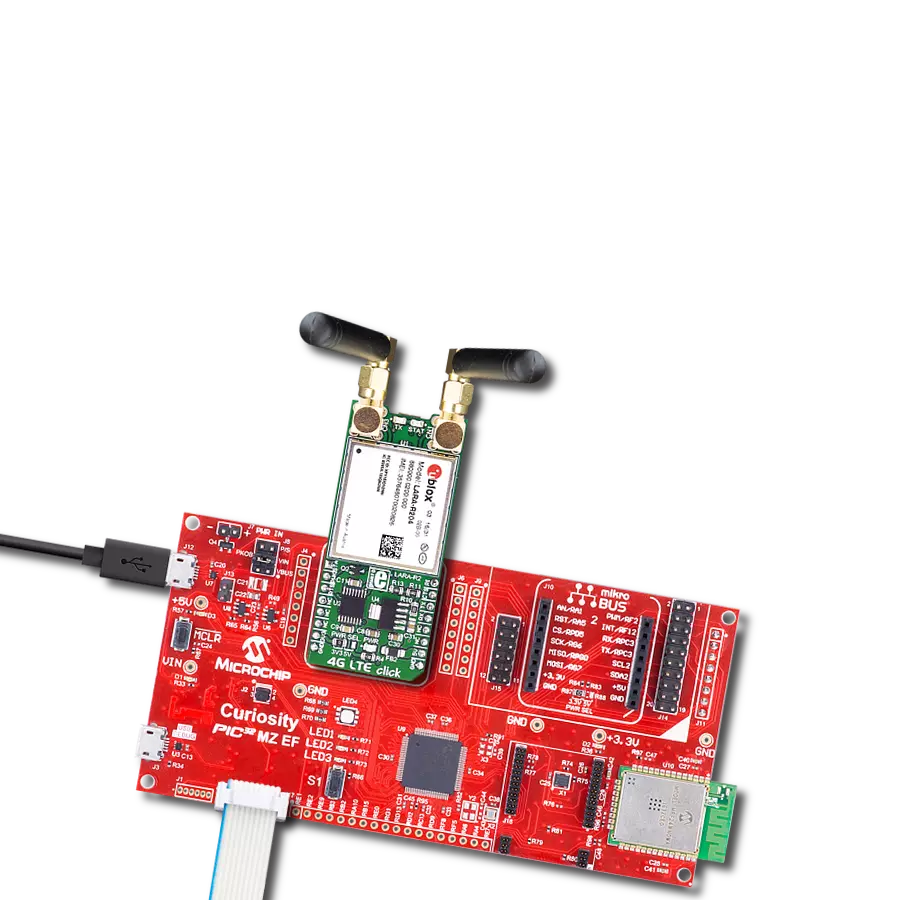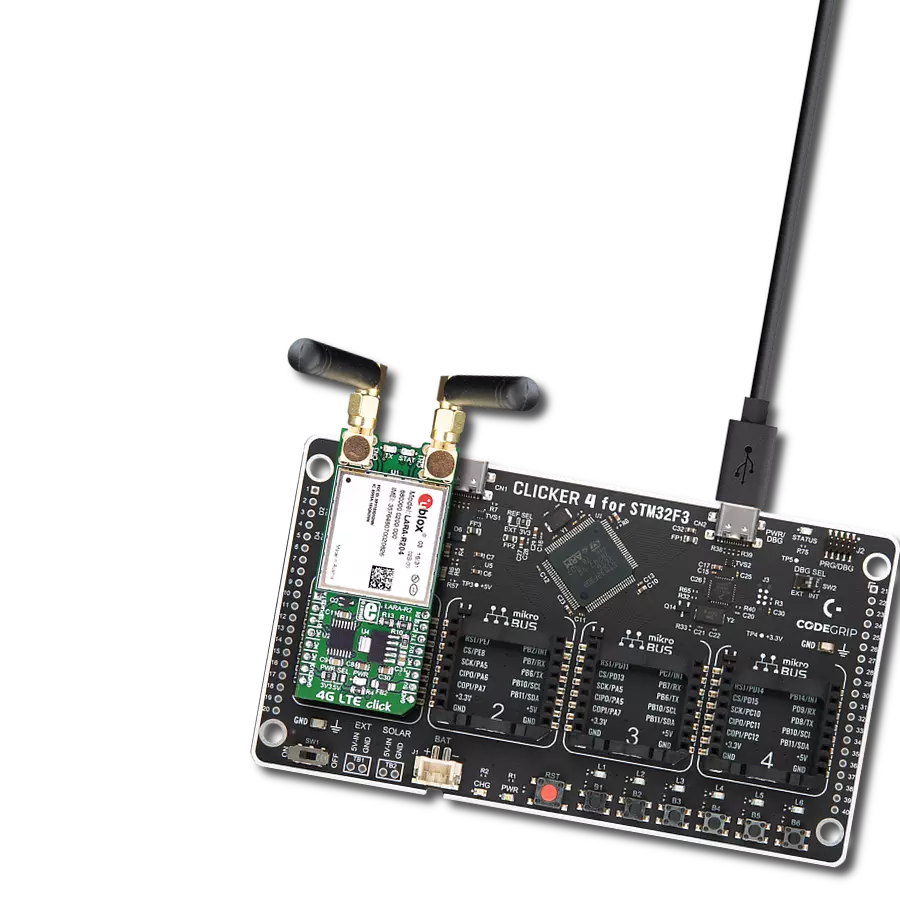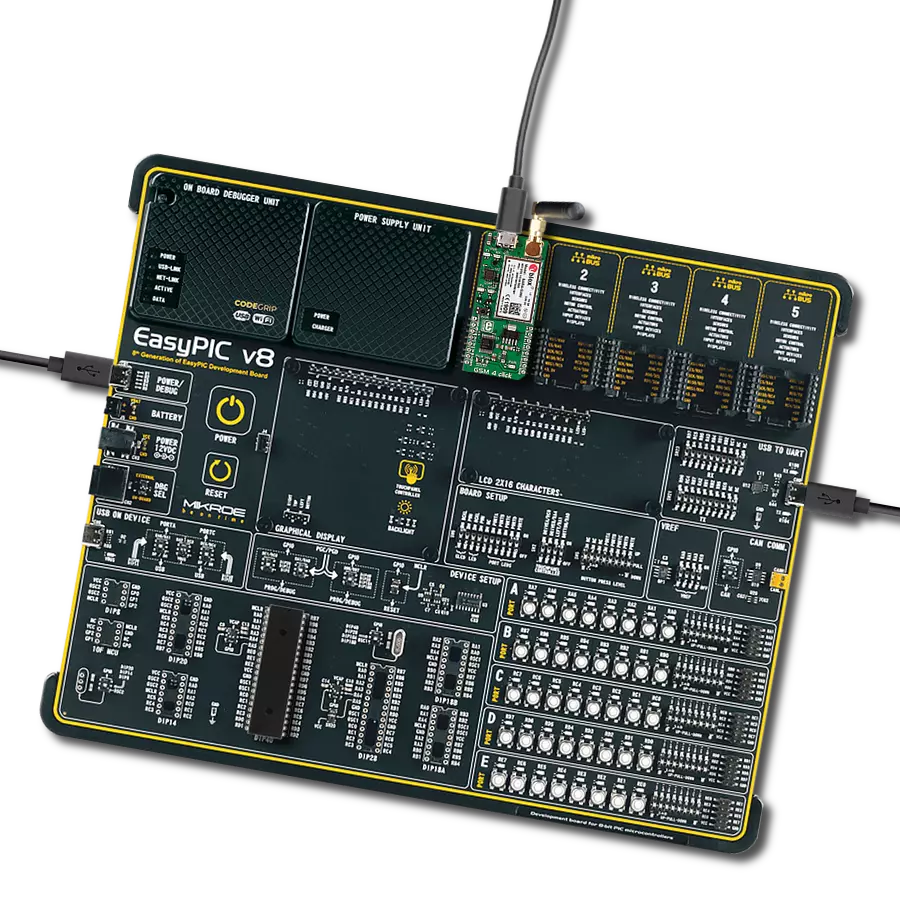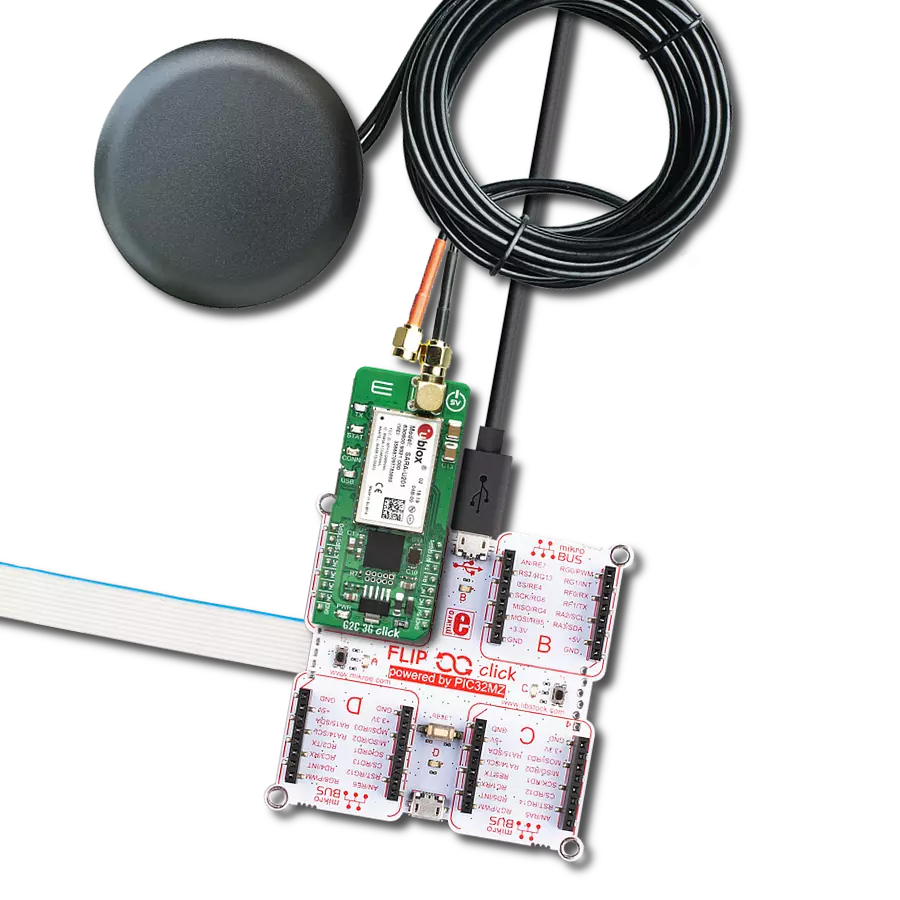Global coverage secure-cloud VoLTE solution
A
A
Hardware Overview
How does it work?
4G LTE 2 Click - Voice is based on the LARA-R6001, a multi-band and multi-mode module from Trasna. It supports LTE Cat 1 FDD and LTE Cat 1 TDD radio access technology (18 LTE bands), with 3G UMTS/HSPA and 2G GSM/GPRS/EGPRS fallback, providing an ideal solution for global connectivity. This Click board™ represents a data and voice solution with worldwide coverage and all relevant MNO certifications, offering great flexibility. Versatile interfaces and features make the LARA-R6001D ideally suited for a wide range of applications that require medium data speed, superior coverage, and streaming data like asset tracking, telematics, remote monitoring, point-of-sale terminals, and more. The LARA-R6001 module provides Voice over LTE (VoLTE) and Circuit-Switched-Fall-Back (CSFB) from LTE to 3G or 2G radio bearer for audio services - access is via an onboard 3.5mm audio jack. This audio interface is configurable through the AT commands to transfer digital audio data to/from an external device as an onboard audio codec. This module requires a 3.8V power supply. Therefore, the Click board™ incorporates an integrated buck (step-down DC-DC)
converter, the TPS7A7002 by Texas Instruments, which provides a stable 3.8V power supply and can mitigate voltage drops at the input when a high current peak appears (typically at the StartUp of the device). The module Ignition (Power-On) pin, labeled as PWR and routed to the RST pin on the mikroBUS™ socket, enables power to be switched on and off. The LARA-R6001 communicates with an MCU using the UART interface with commonly used UART RX and TX pins with the hardware flow control pins UART CTS, RTS, RI (Clear to Send, Ready to Send, and Ring Indicator). It operates at 115200 bps by default configuration to transmit and exchange data with the host MCU through AT commands that Trasna provides. Besides the UART interface, the LARA-R6001 also allows the I2C interface as an I2C host, which can communicate with I2C local devices following the I2C bus specifications. This Click board™ is also equipped with a USB type C connector, available for diagnostic purposes only. The module is a USB device and can be connected to any USB host with compatible drivers. Among its used pins, this Click board™ also possesses two additional
LED indicators: the yellow LED labeled as STATUS, routed both to the mikroBUS™ AN pin (STS) and the LED, used to indicate the status of the network connection visually; and a red LED, labeled as TX, used to tell the transmitting status of the module. LTE cellular networks use spatial multiplexing antenna technology, allowing more than one antenna to be used for better reception. For that reason, besides the primary TX/RX antenna, this Click board™ uses a secondary diversity RX antenna, which allows better signal reception. Alongside those SMA connectors, the 4G LTE 2 Click also has a Nano-SIM card slot that provides multiple connections and interface options alongside several test points labeled from TP1 to TP3, enabling easy reboot and testing of the module. This Click board™ can operate with either 3.3V or 5V logic voltage levels selected via the VCC SEL jumper. This way, both 3.3V and 5V capable MCUs can use the communication lines properly. However, the Click board™ comes equipped with a library containing easy-to-use functions and an example code that can be used, as a reference, for further development.

Features overview
Development board
Clicker 4 for STM32F4 is a compact development board designed as a complete solution that you can use to quickly build your own gadgets with unique functionalities. Featuring an STM32F407VGT6 MCU, four mikroBUS™ sockets for Click boards™ connectivity, power management, and more, it represents a perfect solution for the rapid development of many different types of applications. At its core is an STM32F407VGT6 MCU, a powerful microcontroller by STMicroelectronics based on the high-performance
Arm® Cortex®-M4 32-bit processor core operating at up to 168 MHz frequency. It provides sufficient processing power for the most demanding tasks, allowing Clicker 4 to adapt to any specific application requirements. Besides two 1x20 pin headers, four improved mikroBUS™ sockets represent the most distinctive connectivity feature, allowing access to a huge base of Click boards™, growing on a daily basis. Each section of Clicker 4 is clearly marked, offering an intuitive and clean interface. This makes working with the
development board much simpler and, thus, faster. The usability of Clicker 4 doesn’t end with its ability to accelerate the prototyping and application development stages: it is designed as a complete solution that can be implemented directly into any project, with no additional hardware modifications required. Four mounting holes [4.2mm/0.165”] at all four corners allow simple installation by using mounting screws.
Microcontroller Overview
MCU Card / MCU
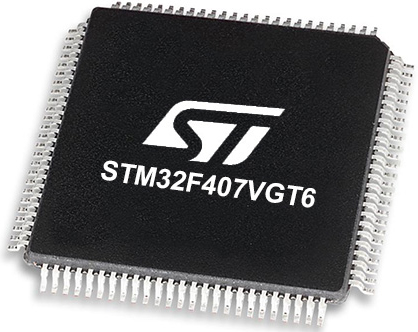
Architecture
ARM Cortex-M4
MCU Memory (KB)
10
Silicon Vendor
STMicroelectronics
Pin count
100
RAM (Bytes)
100
You complete me!
Accessories
This multiband LTE Rubber Antenna with adjustable angle is an excellent choice for all 3G/4G LTE-based click boards from our offer, as well as other devices that require excellent throughput on all major cellular bands worldwide. The antenna has an SMA male connector, which allows it to be mounted directly on the Click board™ or the female SMA module connector. The antenna position can be adjusted in 45⁰ increments (0⁰/45⁰/90⁰).
Used MCU Pins
mikroBUS™ mapper
Take a closer look
Click board™ Schematic

Step by step
Project assembly
Software Support
Library Description
This library contains API for 4G LTE 2 Voice Click driver.
Key functions:
c4glte2voice_set_power_stateThis function sets a desired power state by toggling the PWR pin with a specific time for a high state.c4glte2voice_set_sim_apnThis function sets APN for a sim card.c4glte2voice_send_sms_textThis function sends a text message to a phone number.
Open Source
Code example
The complete application code and a ready-to-use project are available through the NECTO Studio Package Manager for direct installation in the NECTO Studio. The application code can also be found on the MIKROE GitHub account.
/*!
* @file main.c
* @brief 4G LTE 2 Voice Click Example.
*
* # Description
* Application example shows device capability of connecting to the network and
* sending SMS or TCP/UDP messages using standard "AT" commands.
*
* The demo application is composed of two sections :
*
* ## Application Init
* Initializes the driver, restarts the module and tests the communication.
*
* ## Application Task
* Application task is split in few stages:
* - C4GLTE2VOICE_CONFIGURE_FOR_NETWORK:
* Sets configuration to device to be able to connect to the network.
*
* - C4GLTE2VOICE_WAIT_FOR_CONNECTION:
* Waits for the network registration indicated via CREG URC event and then checks the connection status.
*
* - C4GLTE2VOICE_CONFIGURE_FOR_EXAMPLE:
* Sets the device configuration for sending SMS or TCP/UDP messages depending on the selected demo example.
*
* - C4GLTE2VOICE_EXAMPLE:
* Depending on the selected demo example, it sends an SMS message (in PDU or TXT mode) or TCP/UDP message.
*
* By default, the TCP/UDP example is selected.
*
* ## Additional Function
* - static void c4glte2voice_clear_app_buf ( void )
* - static err_t c4glte2voice_process ( void )
* - static void c4glte2voice_error_check( err_t error_flag )
* - static void c4glte2voice_log_app_buf ( void )
* - static err_t c4glte2voice_rsp_check ( void )
* - static err_t c4glte2voice_configure_for_network( void )
* - static err_t c4glte2voice_check_connection( void )
* - static err_t c4glte2voice_configure_for_example( void )
* - static err_t c4glte2voice_example( void )
*
* @note
* In order for the examples to work, user needs to set the APN and SMSC (SMS PDU mode only)
* of entered SIM card as well as the phone number (SMS mode only) to which he wants to send an SMS.
* Enter valid values for the following macros: SIM_APN, SIM_SMSC and PHONE_NUMBER_TO_MESSAGE.
* Example:
SIM_APN "internet"
SIM_SMSC "+381610401"
PHONE_NUMBER_TO_MESSAGE "+381659999999"
*
* @author Stefan Filipovic
*
*/
#include "board.h"
#include "log.h"
#include "c4glte2voice.h"
#include "generic_pointer.h"
#include "conversions.h"
// Example selection macros
#define EXAMPLE_TCP_UDP 0 // Example of sending messages to a TCP/UDP echo server
#define EXAMPLE_SMS 1 // Example of sending SMS to a phone number
#define DEMO_EXAMPLE EXAMPLE_TCP_UDP // Example selection macro
// SIM APN config
#define SIM_APN "" // Set valid SIM APN
// SMS example parameters
#define SIM_SMSC "" // Set valid SMS Service Center Address - only in SMS PDU mode
#define PHONE_NUMBER_TO_MESSAGE "" // Set Phone number to message
#define SMS_MODE "1" // SMS mode: "0" - PDU, "1" - TXT
// TCP/UDP example parameters
#define REMOTE_IP "77.46.162.162" // TCP/UDP echo server IP address
#define REMOTE_PORT "51111" // TCP/UDP echo server port
// Message content
#define MESSAGE_CONTENT "4G LTE 2 Voice Click board - demo example."
// Application buffer size
#define PROCESS_BUFFER_SIZE 300
/**
* @brief Example states.
* @details Predefined enum values for application example state.
*/
typedef enum
{
C4GLTE2VOICE_CONFIGURE_FOR_NETWORK = 1,
C4GLTE2VOICE_WAIT_FOR_CONNECTION,
C4GLTE2VOICE_CONFIGURE_FOR_EXAMPLE,
C4GLTE2VOICE_EXAMPLE
} c4glte2voice_example_state_t;
static c4glte2voice_t c4glte2voice;
static log_t logger;
/**
* @brief Application example variables.
* @details Variables used in application example.
*/
static char app_buf[ PROCESS_BUFFER_SIZE ] = { 0 };
static int32_t app_buf_len = 0;
static int32_t app_buf_cnt = 0;
static err_t error_flag;
static c4glte2voice_example_state_t example_state;
/**
* @brief Clearing application buffer.
* @details This function clears memory of application
* buffer and reset its length and counter.
*/
static void c4glte2voice_clear_app_buf ( void );
/**
* @brief Data reading function.
* @details This function reads data from device and
* appends it to the application buffer.
* @return @li @c 0 - Some data is read.
* @li @c -1 - Nothing is read.
* See #err_t definition for detailed explanation.
*/
static err_t c4glte2voice_process ( void );
/**
* @brief Check for errors.
* @details This function checks for different types of
* errors and logs them on UART or logs the response if no errors occured.
*/
static void c4glte2voice_error_check( err_t error_flag );
/**
* @brief Logs application buffer.
* @details This function logs data from application buffer.
*/
static void c4glte2voice_log_app_buf ( void );
/**
* @brief Response check.
* @details This function checks for response and
* returns the status of response.
* @return @li @c 0 - OK response.
* @li @c -2 - Timeout error.
* @li @c -3 - Command error.
* @li @c -4 - Unknown error.
* See #err_t definition for detailed explanation.
*/
static err_t c4glte2voice_rsp_check ( void );
/**
* @brief Configure device for connection to the network.
* @details Sends commands to configure and enable
* connection to the specified network.
* @return @li @c 0 - OK response.
* @li @c -2 - Timeout error.
* @li @c -3 - Command error.
* @li @c -4 - Unknown error.
* See #err_t definition for detailed explanation.
*/
static err_t c4glte2voice_configure_for_network( void );
/**
* @brief Wait for connection signal.
* @details Wait for connection signal from CREG URC.
* @return @li @c 0 - OK response.
* @li @c -2 - Timeout error.
* @li @c -3 - Command error.
* @li @c -4 - Unknown error.
* See #err_t definition for detailed explanation.
*/
static err_t c4glte2voice_check_connection( void );
/**
* @brief Configure device for example.
* @details Configure device for the specified example.
* @return @li @c 0 - OK response.
* @li @c -2 - Timeout error.
* @li @c -3 - Command error.
* @li @c -4 - Unknown error.
* See #err_t definition for detailed explanation.
*/
static err_t c4glte2voice_configure_for_example( void );
/**
* @brief Execute example.
* @details This function executes SMS or TCP/UDP example depending on the DEMO_EXAMPLE macro.
* @return @li @c 0 - OK response.
* @li @c -2 - Timeout error.
* @li @c -3 - Command error.
* @li @c -4 - Unknown error.
* See #err_t definition for detailed explanation.
*/
static err_t c4glte2voice_example( void );
void application_init ( void )
{
log_cfg_t log_cfg; /**< Logger config object. */
c4glte2voice_cfg_t c4glte2voice_cfg; /**< Click config object. */
/**
* Logger initialization.
* Default baud rate: 115200
* Default log level: LOG_LEVEL_DEBUG
* @note If USB_UART_RX and USB_UART_TX
* are defined as HAL_PIN_NC, you will
* need to define them manually for log to work.
* See @b LOG_MAP_USB_UART macro definition for detailed explanation.
*/
LOG_MAP_USB_UART( log_cfg );
log_init( &logger, &log_cfg );
log_info( &logger, " Application Init " );
// Click initialization.
c4glte2voice_cfg_setup( &c4glte2voice_cfg );
C4GLTE2VOICE_MAP_MIKROBUS( c4glte2voice_cfg, MIKROBUS_1 );
if ( UART_ERROR == c4glte2voice_init( &c4glte2voice, &c4glte2voice_cfg ) )
{
log_error( &logger, " Application Init Error. " );
log_info( &logger, " Please, run program again... " );
for ( ; ; );
}
c4glte2voice_set_power_state ( &c4glte2voice, C4GLTE2VOICE_POWER_STATE_OFF );
c4glte2voice_set_power_state ( &c4glte2voice, C4GLTE2VOICE_POWER_STATE_ON );
c4glte2voice_process( );
c4glte2voice_clear_app_buf( );
app_buf_len = 0;
app_buf_cnt = 0;
// Check communication
c4glte2voice_send_cmd( &c4glte2voice, C4GLTE2VOICE_CMD_AT );
error_flag = c4glte2voice_rsp_check( );
c4glte2voice_error_check( error_flag );
log_info( &logger, " Application Task " );
example_state = C4GLTE2VOICE_CONFIGURE_FOR_NETWORK;
}
void application_task ( void )
{
switch ( example_state )
{
case C4GLTE2VOICE_CONFIGURE_FOR_NETWORK:
{
if ( C4GLTE2VOICE_OK == c4glte2voice_configure_for_network( ) )
{
example_state = C4GLTE2VOICE_WAIT_FOR_CONNECTION;
}
break;
}
case C4GLTE2VOICE_WAIT_FOR_CONNECTION:
{
if ( C4GLTE2VOICE_OK == c4glte2voice_check_connection( ) )
{
example_state = C4GLTE2VOICE_CONFIGURE_FOR_EXAMPLE;
}
break;
}
case C4GLTE2VOICE_CONFIGURE_FOR_EXAMPLE:
{
if ( C4GLTE2VOICE_OK == c4glte2voice_configure_for_example( ) )
{
example_state = C4GLTE2VOICE_EXAMPLE;
}
break;
}
case C4GLTE2VOICE_EXAMPLE:
{
c4glte2voice_example( );
break;
}
default:
{
log_error( &logger, " Example state." );
break;
}
}
}
int main ( void )
{
/* Do not remove this line or clock might not be set correctly. */
#ifdef PREINIT_SUPPORTED
preinit();
#endif
application_init( );
for ( ; ; )
{
application_task( );
}
return 0;
}
static void c4glte2voice_clear_app_buf ( void )
{
memset( app_buf, 0, app_buf_len );
app_buf_len = 0;
app_buf_cnt = 0;
}
static err_t c4glte2voice_process ( void )
{
int32_t rx_size;
char rx_buff[ PROCESS_BUFFER_SIZE ] = { 0 };
rx_size = c4glte2voice_generic_read( &c4glte2voice, rx_buff, PROCESS_BUFFER_SIZE );
if ( rx_size > 0 )
{
int32_t buf_cnt = 0;
if ( ( app_buf_len + rx_size ) > PROCESS_BUFFER_SIZE )
{
c4glte2voice_clear_app_buf( );
return C4GLTE2VOICE_ERROR;
}
else
{
buf_cnt = app_buf_len;
app_buf_len += rx_size;
}
for ( int32_t rx_cnt = 0; rx_cnt < rx_size; rx_cnt++ )
{
if ( rx_buff[ rx_cnt ] != 0 )
{
app_buf[ ( buf_cnt + rx_cnt ) ] = rx_buff[ rx_cnt ];
}
else
{
app_buf_len--;
buf_cnt--;
}
}
return C4GLTE2VOICE_OK;
}
return C4GLTE2VOICE_ERROR;
}
static err_t c4glte2voice_rsp_check ( void )
{
uint32_t timeout_cnt = 0;
uint32_t timeout = 120000;
err_t error_flag = c4glte2voice_process( );
if ( ( C4GLTE2VOICE_OK != error_flag ) && ( C4GLTE2VOICE_ERROR != error_flag ) )
{
return error_flag;
}
while ( ( 0 == strstr( app_buf, C4GLTE2VOICE_RSP_OK ) ) &&
( 0 == strstr( app_buf, C4GLTE2VOICE_RSP_ERROR ) ) )
{
error_flag = c4glte2voice_process( );
if ( ( C4GLTE2VOICE_OK != error_flag ) && ( C4GLTE2VOICE_ERROR != error_flag ) )
{
return error_flag;
}
if ( timeout_cnt++ > timeout )
{
c4glte2voice_clear_app_buf( );
return C4GLTE2VOICE_ERROR_TIMEOUT;
}
Delay_ms ( 1 );
}
if ( strstr( app_buf, C4GLTE2VOICE_RSP_OK ) )
{
return C4GLTE2VOICE_OK;
}
else if ( strstr( app_buf, C4GLTE2VOICE_RSP_ERROR ) )
{
return C4GLTE2VOICE_ERROR_CMD;
}
else
{
return C4GLTE2VOICE_ERROR_UNKNOWN;
}
}
static void c4glte2voice_error_check( err_t error_flag )
{
switch ( error_flag )
{
case C4GLTE2VOICE_OK:
{
c4glte2voice_log_app_buf( );
break;
}
case C4GLTE2VOICE_ERROR:
{
log_error( &logger, " Overflow!" );
break;
}
case C4GLTE2VOICE_ERROR_TIMEOUT:
{
log_error( &logger, " Timeout!" );
break;
}
case C4GLTE2VOICE_ERROR_CMD:
{
log_error( &logger, " CMD!" );
break;
}
case C4GLTE2VOICE_ERROR_UNKNOWN:
default:
{
log_error( &logger, " Unknown!" );
break;
}
}
c4glte2voice_clear_app_buf( );
Delay_ms ( 500 );
}
static void c4glte2voice_log_app_buf ( void )
{
for ( int32_t buf_cnt = 0; buf_cnt < app_buf_len; buf_cnt++ )
{
log_printf( &logger, "%c", app_buf[ buf_cnt ] );
}
}
static err_t c4glte2voice_configure_for_network( void )
{
err_t func_error = C4GLTE2VOICE_OK;
// Deregister from network
#define DEREGISTER_FROM_NETWORK "2"
c4glte2voice_send_cmd_with_parameter( &c4glte2voice, C4GLTE2VOICE_CMD_COPS, DEREGISTER_FROM_NETWORK );
error_flag = c4glte2voice_rsp_check();
func_error |= error_flag;
c4glte2voice_error_check( error_flag );
// Set SIM APN
c4glte2voice_set_sim_apn( &c4glte2voice, SIM_APN );
error_flag = c4glte2voice_rsp_check();
func_error |= error_flag;
c4glte2voice_error_check( error_flag );
// Enable full functionality
#define FULL_FUNCTIONALITY "1"
c4glte2voice_send_cmd_with_parameter( &c4glte2voice, C4GLTE2VOICE_CMD_CFUN, FULL_FUNCTIONALITY );
error_flag = c4glte2voice_rsp_check();
func_error |= error_flag;
c4glte2voice_error_check( error_flag );
// Automatic registration
#define AUTOMATIC_REGISTRATION "0"
c4glte2voice_send_cmd_with_parameter( &c4glte2voice, C4GLTE2VOICE_CMD_COPS, AUTOMATIC_REGISTRATION );
error_flag = c4glte2voice_rsp_check();
func_error |= error_flag;
c4glte2voice_error_check( error_flag );
// Enable network registartion
#define ENABLE_REG "2"
c4glte2voice_send_cmd_with_parameter( &c4glte2voice, C4GLTE2VOICE_CMD_CREG, ENABLE_REG );
error_flag = c4glte2voice_rsp_check();
func_error |= error_flag;
c4glte2voice_error_check( error_flag );
return func_error;
}
static err_t c4glte2voice_check_connection( void )
{
#define CONNECTED "+CREG: 1"
c4glte2voice_process( );
if ( strstr( app_buf, CONNECTED ) )
{
Delay_ms ( 100 );
c4glte2voice_process( );
c4glte2voice_log_app_buf( );
log_printf( &logger, "\r\n" );
c4glte2voice_clear_app_buf( );
// Check signal quality
c4glte2voice_send_cmd( &c4glte2voice, C4GLTE2VOICE_CMD_CSQ );
error_flag = c4glte2voice_rsp_check( );
c4glte2voice_error_check( error_flag );
return error_flag;
}
return C4GLTE2VOICE_ERROR;
}
static err_t c4glte2voice_configure_for_example( void )
{
err_t func_error = C4GLTE2VOICE_OK;
#if ( DEMO_EXAMPLE == EXAMPLE_TCP_UDP )
#define ACTIVATE_PDP_CONTEXT "1,1"
c4glte2voice_send_cmd_with_parameter( &c4glte2voice, C4GLTE2VOICE_CMD_CGACT, ACTIVATE_PDP_CONTEXT );
error_flag = c4glte2voice_rsp_check( );
func_error |= error_flag;
c4glte2voice_error_check( error_flag );
#elif ( DEMO_EXAMPLE == EXAMPLE_SMS )
c4glte2voice_send_cmd_with_parameter( &c4glte2voice, C4GLTE2VOICE_CMD_CMGF, SMS_MODE );
error_flag = c4glte2voice_rsp_check( );
func_error |= error_flag;
c4glte2voice_error_check( error_flag );
#else
#error "No demo example selected"
#endif
return func_error;
}
static err_t c4glte2voice_example( void )
{
err_t func_error = C4GLTE2VOICE_OK;
#if ( DEMO_EXAMPLE == EXAMPLE_TCP_UDP )
char cmd_buf[ 100 ] = { 0 };
char urc_buf[ 20 ] = { 0 };
uint16_t timeout_cnt = 0;
uint16_t timeout = 30000;
uint8_t * __generic_ptr socket_num_buf = 0;
uint8_t tcp_socket_num[ 2 ] = { 0 };
uint8_t udp_socket_num[ 2 ] = { 0 };
// Create TCP socket
#define RSP_USOCR "+USOCR: "
#define TCP_PROTOCOL "6"
c4glte2voice_send_cmd_with_parameter( &c4glte2voice, C4GLTE2VOICE_CMD_USOCR, TCP_PROTOCOL );
error_flag = c4glte2voice_rsp_check( );
func_error |= error_flag;
socket_num_buf = strstr( app_buf, RSP_USOCR ) + strlen ( RSP_USOCR );
tcp_socket_num[ 0 ] = *socket_num_buf;
c4glte2voice_error_check( error_flag );
// Create UDP socket
#define UDP_PROTOCOL "17"
c4glte2voice_send_cmd_with_parameter( &c4glte2voice, C4GLTE2VOICE_CMD_USOCR, UDP_PROTOCOL );
error_flag = c4glte2voice_rsp_check( );
func_error |= error_flag;
socket_num_buf = strstr( app_buf, RSP_USOCR ) + strlen ( RSP_USOCR );
udp_socket_num[ 0 ] = *socket_num_buf;
c4glte2voice_error_check( error_flag );
// Connect TCP socket to remote IP and port
strcpy( cmd_buf, tcp_socket_num );
strcat( cmd_buf, ",\"" );
strcat( cmd_buf, REMOTE_IP );
strcat( cmd_buf, "\"," );
strcat( cmd_buf, REMOTE_PORT );
c4glte2voice_send_cmd_with_parameter( &c4glte2voice, C4GLTE2VOICE_CMD_USOCO, cmd_buf );
error_flag = c4glte2voice_rsp_check( );
func_error |= error_flag;
c4glte2voice_error_check( error_flag );
// Connect UDP socket to remote IP and port
strcpy( cmd_buf, udp_socket_num );
strcat( cmd_buf, ",\"" );
strcat( cmd_buf, REMOTE_IP );
strcat( cmd_buf, "\"," );
strcat( cmd_buf, REMOTE_PORT );
c4glte2voice_send_cmd_with_parameter( &c4glte2voice, C4GLTE2VOICE_CMD_USOCO, cmd_buf );
error_flag = c4glte2voice_rsp_check( );
func_error |= error_flag;
c4glte2voice_error_check( error_flag );
// Get message length
uint8_t message_len_buf[ 5 ] = { 0 };
uint16_t message_len = strlen( MESSAGE_CONTENT );
uint16_to_str( message_len, message_len_buf );
l_trim( message_len_buf );
r_trim( message_len_buf );
// Write message to TCP socket
strcpy( cmd_buf, tcp_socket_num );
strcat( cmd_buf, "," );
strcat( cmd_buf, message_len_buf );
strcat( cmd_buf, ",\"" );
strcat( cmd_buf, MESSAGE_CONTENT );
strcat( cmd_buf, "\"" );
c4glte2voice_send_cmd_with_parameter( &c4glte2voice, C4GLTE2VOICE_CMD_USOWR, cmd_buf );
error_flag = c4glte2voice_rsp_check( );
func_error |= error_flag;
c4glte2voice_error_check( error_flag );
// Read response message from TCP socket
#define URC_READ_SOCKET_DATA_TCP "+UUSORD: "
strcpy( urc_buf, URC_READ_SOCKET_DATA_TCP );
strcat( urc_buf, tcp_socket_num );
for ( ; ; )
{
c4glte2voice_process( );
uint8_t * __generic_ptr start_response_buf = strstr( app_buf, urc_buf );
if ( start_response_buf )
{
Delay_ms ( 100 );
c4glte2voice_process( );
uint8_t response_len_buf[ 5 ] = { 0 };
char * __generic_ptr start_response_len = strstr( start_response_buf, "," ) + 1;
memcpy ( response_len_buf, start_response_len, app_buf_len - ( start_response_len - app_buf ) );
strcpy( cmd_buf, tcp_socket_num );
strcat( cmd_buf, "," );
strcat( cmd_buf, response_len_buf );
c4glte2voice_log_app_buf( );
c4glte2voice_clear_app_buf( );
c4glte2voice_send_cmd_with_parameter( &c4glte2voice, C4GLTE2VOICE_CMD_USORD, cmd_buf );
error_flag = c4glte2voice_rsp_check( );
func_error |= error_flag;
c4glte2voice_error_check( error_flag );
break;
}
if ( timeout_cnt++ > timeout )
{
break;
}
Delay_ms ( 1 );
}
timeout_cnt = 0;
// Write message to UDP socket
strcpy( cmd_buf, udp_socket_num );
strcat( cmd_buf, "," );
strcat( cmd_buf, message_len_buf );
strcat( cmd_buf, ",\"" );
strcat( cmd_buf, MESSAGE_CONTENT );
strcat( cmd_buf, "\"" );
c4glte2voice_send_cmd_with_parameter( &c4glte2voice, C4GLTE2VOICE_CMD_USOWR, cmd_buf );
error_flag = c4glte2voice_rsp_check( );
func_error |= error_flag;
c4glte2voice_error_check( error_flag );
// Read response message from UDP socket
#define URC_READ_SOCKET_DATA_UDP "+UUSORD: "
strcpy( urc_buf, URC_READ_SOCKET_DATA_UDP );
strcat( urc_buf, udp_socket_num );
for ( ; ; )
{
c4glte2voice_process( );
uint8_t * __generic_ptr start_response_buf = strstr( app_buf, urc_buf );
if ( start_response_buf )
{
Delay_ms ( 100 );
c4glte2voice_process( );
uint8_t response_len_buf[ 5 ] = { 0 };
char * __generic_ptr start_response_len = strstr( start_response_buf, "," ) + 1;
memcpy ( response_len_buf, start_response_len, app_buf_len - ( start_response_len - app_buf ) );
strcpy( cmd_buf, udp_socket_num );
strcat( cmd_buf, "," );
strcat( cmd_buf, response_len_buf );
c4glte2voice_log_app_buf( );
c4glte2voice_clear_app_buf( );
c4glte2voice_send_cmd_with_parameter( &c4glte2voice, C4GLTE2VOICE_CMD_USORD, cmd_buf );
error_flag = c4glte2voice_rsp_check( );
func_error |= error_flag;
c4glte2voice_error_check( error_flag );
break;
}
if ( timeout_cnt++ > timeout )
{
break;
}
Delay_ms ( 1 );
}
// Close TCP socket
c4glte2voice_send_cmd_with_parameter( &c4glte2voice, C4GLTE2VOICE_CMD_USOCL, tcp_socket_num );
error_flag = c4glte2voice_rsp_check( );
func_error |= error_flag;
c4glte2voice_error_check( error_flag );
// Close UDP socket
c4glte2voice_send_cmd_with_parameter( &c4glte2voice, C4GLTE2VOICE_CMD_USOCL, udp_socket_num );
error_flag = c4glte2voice_rsp_check( );
func_error |= error_flag;
c4glte2voice_error_check( error_flag );
Delay_ms ( 1000 );
Delay_ms ( 1000 );
Delay_ms ( 1000 );
Delay_ms ( 1000 );
Delay_ms ( 1000 );
#elif ( DEMO_EXAMPLE == EXAMPLE_SMS )
// Check SMS mode
#define CMGF_PDU "+CMGF: 0"
#define CMGF_TXT "+CMGF: 1"
c4glte2voice_send_cmd_check( &c4glte2voice, C4GLTE2VOICE_CMD_CMGF );
error_flag = c4glte2voice_rsp_check( );
func_error |= error_flag;
if ( strstr( app_buf, CMGF_PDU ) )
{
c4glte2voice_error_check( error_flag );
// Send SMS in PDU mode
c4glte2voice_send_sms_pdu( &c4glte2voice, SIM_SMSC, PHONE_NUMBER_TO_MESSAGE, MESSAGE_CONTENT );
error_flag = c4glte2voice_rsp_check( );
func_error |= error_flag;
}
else if ( strstr( app_buf, CMGF_TXT ) )
{
c4glte2voice_error_check( error_flag );
// Send SMS in TXT mode
c4glte2voice_send_sms_text ( &c4glte2voice, PHONE_NUMBER_TO_MESSAGE, MESSAGE_CONTENT );
error_flag = c4glte2voice_rsp_check( );
func_error |= error_flag;
}
c4glte2voice_error_check( error_flag );
// 30 seconds delay
Delay_ms ( 1000 );
Delay_ms ( 1000 );
Delay_ms ( 1000 );
Delay_ms ( 1000 );
Delay_ms ( 1000 );
Delay_ms ( 1000 );
Delay_ms ( 1000 );
Delay_ms ( 1000 );
Delay_ms ( 1000 );
Delay_ms ( 1000 );
Delay_ms ( 1000 );
Delay_ms ( 1000 );
Delay_ms ( 1000 );
Delay_ms ( 1000 );
Delay_ms ( 1000 );
Delay_ms ( 1000 );
Delay_ms ( 1000 );
Delay_ms ( 1000 );
Delay_ms ( 1000 );
Delay_ms ( 1000 );
Delay_ms ( 1000 );
Delay_ms ( 1000 );
Delay_ms ( 1000 );
Delay_ms ( 1000 );
Delay_ms ( 1000 );
Delay_ms ( 1000 );
Delay_ms ( 1000 );
Delay_ms ( 1000 );
Delay_ms ( 1000 );
Delay_ms ( 1000 );
#else
#error "No demo example selected"
#endif
return func_error;
}
// ------------------------------------------------------------------------ END
Additional Support
Resources
Category:GSM/LTE
